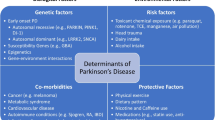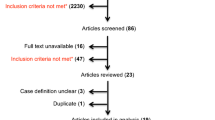Summary
The data on “the city and its epileptics” (BRD) are presented. Under 94000 citizens (14 years and over) 394 persons could be registered with chronic (genuin or symptomatic) epilepsy. The prevalence rate was 0.42% — the incidence rate one tenth of the prevalence. Employees and non-employees show different social structure (accumulation of negative social factors on the one side and over-representation of middle- and upper social class on the other). Social prestige and corresponding behaviour of settlement shows clustering in distinct areas of the city. Education, working-place, settlement and marital status show an attitude towards their chronic disease and a tendency to social immobility. Long-term hospitalisation, pre-term invalidity were seldom encountered. Possibilities for occupation has been good (absence of dangerous places). For therapeutic strategy in epileptics social and epidemiological aspects should be integrated in the mentioned way.
Zusammenfassung
Berichtet wird über „Eine Stadt und ihre Anfallskranken“. Unter 94000 Einwohnern (über 14 Jahre) fanden sich 394 Personen mit chronischer (genuiner oder symptomatischer) Epilepsie. Die Prävalenzrate betrug 0,42% — die jährliche Incidenz ein Zehntel davon. Erwerbspersonen und Nichterwerbs-personen zeigten differente Sozialstruktur (Kumulierung negativer Sozialmerkmale bei Berufstätigen einerseits, Überrepräsentation von Mittel- und Oberschicht unter Nichterwerbstätigen andererseits). Sozialer Status und davon abhängiges Siedlungsverhalten verursachte Clusterbildung innerhalb bestimmter Wohnbezirke. In bezug auf Ausbildung, Arbeitsplatz, Wohnsitz und Familienstand war das Risikoverhalten orientiert am Faktum chronischen Krankseins, d. h. verändert im Sinne sozialer Immobilität. Dauerhospitalisierung war sehr selten, vorzeitige Berentung nicht häufig, die Arbeitsmarktlage günstig (Fehlen gefahrengeneigter Arbeitsplätze). In die Planungen zur Therapie bei Epilepsie sollten soziale und epidemiologische Aspekte der referierten Art integriert werden.
Similar content being viewed by others
Literatur
Alström, C. H.: A study of epilepsy in its clinical, social and genetic aspects. Acta Psychiat. Neurol. Scand., Suppl. 63. Copenhagen: Munksgaard 1950
Arnold, O. H.: Epilepsie — eine statistische Studie am Material einer Epileptikerambulanz. Wien. Z. Nervenheilk. 9, 259–418 (1954)
Conrad, K.: Der Erbkreis der Epilepsie. In: Just, G., Hdb. d. Erbbiologie d. Menschen, Bd. V/2. Berlin: Springer 1939
De Carazzo, G. C.: Ein Versuch zur Erforschung der Einstellungen gegenüber psychisch Kranken. Social Psychiat. 6/1, 34–39 (1971)
Dörner, K.: Bürger und Irre — Zur Sozialgeschichte und Wissenschaftssoziologie der Psychiatrie. Frankfurt a. M.: Europ. Verl.-Anst. 1969
Fremming, K.: Sygdomsrisikoen for sindslidelser og andre sjaelelige abnormtilstande iden danske genemsnits befolkning. Copenhagen: Munksgaard 1947 (zit. nach Harvald)
Goodglass, H., Morgan, M., Folsom, A. T., Quadfasel, F. A.: Epileptic seizures, psychological factors and occupational adjustment. Epilepsia (Amst.) 4, 322 (1963)
Gudmundson, G.: Epilepsy in Iceland — A clinical and epidemiological investigation. Acta Neurol. Scand., Suppl. 43. Copenhagen: Munksgaard 1960
Harvald, B.: Genetik der Epilepsien. Psychiatrie d. Gegenwart, Bd. II/2, S. 691–712. Berlin-Heidelberg-New York: Springer 1972
Hauck, G.: Soziale Ursachen und Folgen von kindlicher Epilepsie. Social Psychiat. 4/1, 32–42 (1969) (und persönliche Mitteilung)
Helgason, T.: Epidemiology of mental disorders in Iceland. Acta Psychiat. Scand., Suppl. 173. Copenhagen: Munksgaard 1964
Henriksen, G. F.: The role of special centers in the care of epileptics in Norway. Epilepsia (Amst.) 13/1, 199–204 (1972)
Herlyn, U.: Innenstadterneuerung — Materialbericht. Göttingen: Ms. Soz. Sem. 1970
Jaeckel, M., Wieser, St.: Das Bild des Geisteskranken in der Öffentlichkeit. Slg. psychiat. neurol. Einzeldarst. Stuttgart: Thieme 1970
Janz, D.: Anfalls-Syndrome; Epidemiologie. Psychiatrie d. Gegenwart, Bd. II/2, S. 565. Berlin-Heidelberg-New York: Springer 1972
Janz, D.: Social prognosis in epilepsy especially in regard to social status and the necessity for institutionalisation. Epilepsia (Amst.) 13/1, 141–147 (1972)
Juul-Jensen, P.: Epilepsy — a clinical and social analysis of 1020 adult patients with epileptic seizures. Acta Neurol. Scand. N.S., Suppl. 5, Bd. 40. Copenhagen: Munksgaard 1964
Kaluza, I.: Sozialschicksal bei Epileptikern. Katamnestische Untersuchungen an 3 Jahrgängen der Anfallsambulanz der Nervenklinik der Universität Heidelberg. Dissertation 1967
Krohn, W.: Study of epilepsy in northern Norway, its frequency and character. Acta Psychiat. Neurol. Scand., Suppl. 150. Copenhagen: Munksgaard 1961
Kurland, L. T.: The incidence and prevalence of convulsive disorders in a small urban community. Epilepsia (Amst.) 1, 143–161 (1959/60)
Leibowitz, U., Alter, M.: Epilepsy in Jerusalem, Israel. Epilepsia (Amst.) 9, 87–105 (1968)
Lorgé, M.: Epilepsie und Lebensschicksal. Ergebnisse katamnestischer Untersuchungen. Psychiat. et Neurol. (Basel) 147, 360–381 (1964)
Moore, H., Kleining, G.: Das soziale Selbstbild der Gesellschaftsschichten in Deutschland. Kölner Z. Soziol. Psychol. 12, 86–119 (1960)
Penin, H.: Der soziale Aufstieg der Rentenbewerber mit Epilepsie. Nervenarzt 40/10, 466–469 (1969)
Pond, D. A., Bidwell, B. H.: A survey of epilepsy in fourteen general practices. II: Social and psychological aspects. Epilepsia (Amst.) 1, 285–299 (1959/60)
Rabe, Fr.: Invalidität und Epilepsie. Nervenarzt 32/6, 283–288 (1961)
Strömgren, E.: Beitrag zur psychiatrischen Erblehre auf Grund von Untersuchungen an einer Inselbevölkerung. Copenhagen: Munksgaard 1938
Strotzka, H.: Kleinburg — Eine sozialpsychiatrische Feldstudie. Wien: Österr. Bundesverlag 1969
Strotzka, H., Simon, M. D., Simy, P., Kunze, E., Stadler, H.: Interdependenzen sozialer Desintegration. Social Psychiat. 6/4, 158–166 (1971)
Author information
Authors and Affiliations
Additional information
Herrn Professor H. J. Bauer in dankbarer Verbundenheit zu seinem 60. Geburtstag gewidmet.
Rights and permissions
About this article
Cite this article
Ritter, G. Soziale und epidemiologische Befunde bei Epilepsie. Z. Neurol. 206, 209–222 (1974). https://doi.org/10.1007/BF00316535
Received:
Issue Date:
DOI: https://doi.org/10.1007/BF00316535




